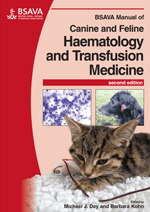
Full text loading...

Leukaemia is a malignant transformation of cells of the haemopoietic system and is characterized by an abnormal proliferation of blood cells, usually white blood cells. Leukaemia is a broad term covering a spectrum of diseases that includes acute leukaemia, chronic leukaemia and the leukaemic phase of lymphoma. Although Leukaemia is not a common condition, it is important because of the diagnostic challenges in distinguishing the different types, which have varying treatment outcomes and prognoses. This chapter considers the haemopoietic system – leucocyte lineages; aetiology; acute leukaemia; chronic leukaemia; myelodysplastic syndrome; general approach to the leukaemic patient; management of leukaemia. Case examples: An 11-year-old female Golden Retriever weighing 32.0 kg; A 9.5-year-old neutered Boxer weighing 30.2 kg.
Leukaemia, Page 1 of 1
< Previous page | Next page > /docserver/preview/fulltext/10.22233/9781905319732/9781905319732.16-1.gif

Full text loading...






